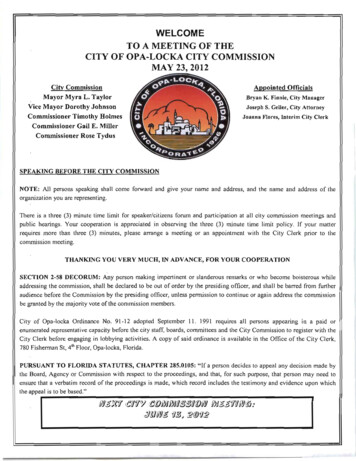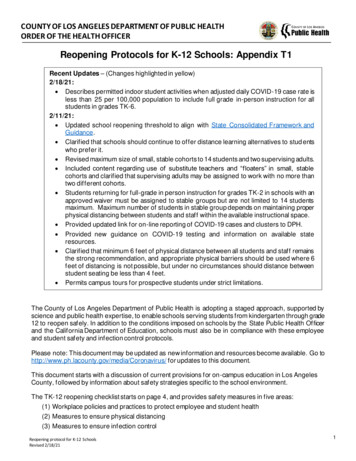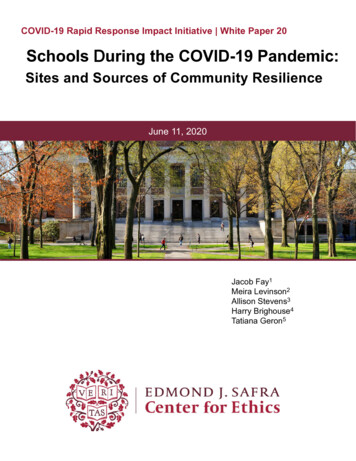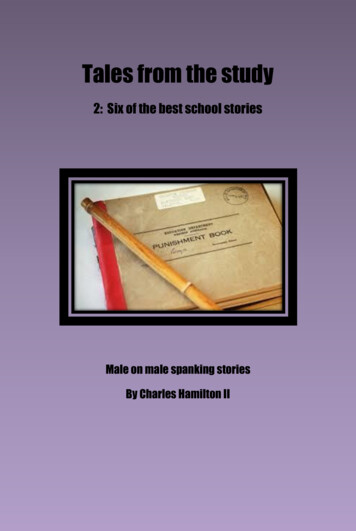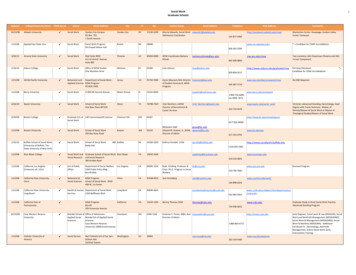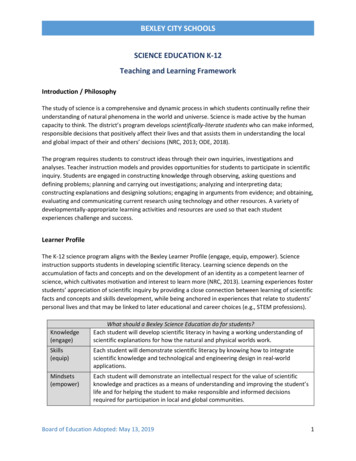
Transcription
BEXLEY CITY SCHOOLSSCIENCE EDUCATION K-12Teaching and Learning FrameworkIntroduction / PhilosophyThe study of science is a comprehensive and dynamic process in which students continually refine theirunderstanding of natural phenomena in the world and universe. Science is made active by the humancapacity to think. The district’s program develops scientifically-literate students who can make informed,responsible decisions that positively affect their lives and that assists them in understanding the localand global impact of their and others’ decisions (NRC, 2013; ODE, 2018).The program requires students to construct ideas through their own inquiries, investigations andanalyses. Teacher instruction models and provides opportunities for students to participate in scientificinquiry. Students are engaged in constructing knowledge through observing, asking questions anddefining problems; planning and carrying out investigations; analyzing and interpreting data;constructing explanations and designing solutions; engaging in arguments from evidence; and obtaining,evaluating and communicating current research using technology and other resources. A variety ofdevelopmentally-appropriate learning activities and resources are used so that each studentexperiences challenge and success.Learner ProfileThe K-12 science program aligns with the Bexley Learner Profile (engage, equip, empower). Scienceinstruction supports students in developing scientific literacy. Learning science depends on theaccumulation of facts and concepts and on the development of an identity as a competent learner ofscience, which cultivates motivation and interest to learn more (NRC, 2013). Learning experiences fosterstudents’ appreciation of scientific inquiry by providing a close connection between learning of scientificfacts and concepts and skills development, while being anchored in experiences that relate to students’personal lives and that may be linked to later educational and career choices (e.g., STEM professions).Knowledge(engage)What should a Bexley Science Education do for students?Each student will develop scientific literacy in having a working understanding ofscientific explanations for how the natural and physical worlds work.Skills(equip)Each student will demonstrate scientific literacy by knowing how to integratescientific knowledge and technological and engineering design in real-worldapplications.Mindsets(empower)Each student will demonstrate an intellectual respect for the value of scientificknowledge and practices as a means of understanding and improving the student’slife and for helping the student to make responsible and informed decisionsrequired for participation in local and global communities.Board of Education Adopted: May 13, 20191
BEXLEY CITY SCHOOLSHigh-Quality Science ProgramsHigh quality programs are aligned to standards for excellence. The district’s science program is alignedto Ohio’s learning standards for science, which are based on the Next Generation Science Standards(NRC, 2013) and include model science curriculum for K-12 courses (ODE, 2018). The program is alsoinformed by the National Research Council, in partnership with multiple entities, which provides aguiding framework for K-12 science to help leaders improve local education systems (NRC, 2012). Bothnational and state standards highlight the need to build students’ proficiency and appreciation forscience over multiple years and indicate that high-quality K-12 programs implement the following: Students are provided with a K-12 seamless continuum of science, using technology and designlearning.District curriculum is developmentally and sequentially appropriate for students at theirparticular grade level and is infused with reading, writing and applied technology learningexperiences and, whenever possible, is connected to other curriculum areas, to societal andenvironmental issues, and to career opportunities.Teachers implement a district-developed aligned science curriculum and work collaboratively forthe development of student learning.Effective instruction is framed and supported with aligned curriculum maps, high-qualityteaching resources, common learning and assessment experiences, differentiated learningoptions, and ongoing professional development for teachers of science.Teachers stay connected to up-to-date science practices and practices that promotecollaboration, creativity and critical thinking, such as Project Based Learning (PBL) and ProjectZero (Harvard University), and by engaging with professional associations, such as the ScienceEducation Council of Ohio (SECO), the National Science Teachers Association (NSTA), and theNational Association for Research in Science Teaching (NARST).Instruction and learning experiences prepare students for the post-secondary workplace andeducation and for being a local and globally responsible citizen.The program reflects current trends and patterns in the job market and with cutting-edgescience and technology, seeking community partnerships for betterment and preparation ofstudents. For example, the high school science program is enhanced and enriched by the YoungScientist in Residence Program, which is funded via the Bexley Education Foundation (BEF), forbringing experts into the science classrooms.Space, facilities, materials, equipment and other resources facilitate effective teaching andlearning of science.Conditions to Support Student LearningProficiency in science is multi-faceted and requires a range of experiences to support students’ learning.Students should be engaged in learning experiences that support their understanding of science as away of knowing, which requires their productive participation in scientific practices and discourse:Board of Education Adopted: May 13, 20192
BEXLEY CITY SCHOOLSEach student will Develop a working understanding ofscientific explanations for how thenatural and physical world works(AAAS, 2007; NRC, 2011, 2012, 2013;NSTA, 2014, 2016a, 2016b, 2016c;ODE, 2018).Teachers will involve students in Generating, understanding, remembering, and usingconcepts, explanations, arguments, models, and factsrelated to science.Observing and asking questions of the natural and physicalworld that can be answered through scientific investigations.Thinking critically and logically to connect evidence andexplanations, also recognizing and analyzing alternativeexplanations and predictions.Demonstrate scientific literacy byknowing how to integrate scientificknowledge and technological andengineering design in real-worldapplications (AAAS, 2007; NRC, 2011,2012, 2013; NSTA, 2014, 2016a,2016b, 2016c; ODE, 2018).Hands-on science that is rigorous and intellectuallychallenging and that provides students with authenticinquiry-based learning.Planning and conducting investigations.Using appropriate mathematics, tools and techniques togather data and information and to assist with analyzing andinterpreting data.Evaluating scientific evidence, making connections toexisting scientific knowledge, and considering informationwithin the framework of local and global issues.Communicating about observations, investigations andexplanations.Develop an intellectual respect for thevalue of scientific knowledge andpractice as a means of understandingand improving our world (AAAS, 2007;NRC, 2011, 2012, 2013; NSTA, 2014,2016a, 2016b, 2016c; ODE, 2018).Evaluating science as it affects their lives and their local andglobal communities.Recognizing how scientific and technology advances mayaffect the environment positively or negatively.Making responsible and informed decisions and addressingethical challenges.K-12 Program OverviewThe district’s program consists of a standards-based curriculum anchored in the study of life science,earth and space science, and physical science (ODE, 2018). Ohio’s standards require that studentsdevelop an understanding of the interconnections within the sciences and the interactions amongscience, society and environment. The standards are based on inquiry, which requires students’ to havehands-on involvement and application and synthesis of their knowledge of science in real-worldsituations. Teaching and learning science also overlaps with applications of technology, engineering,design, mathematics, and writing (i.e., informational, argumentation). This overlap is manifested inscientific inquiry that begins with a problem finding and solving approach using these multipleapplications.Board of Education Adopted: May 13, 20193
BEXLEY CITY SCHOOLSElementary ScienceScience in grades K-5 consists of three strands: Life Science, Earth and Space Science, and PhysicalScience. Each grade engages students in units that align with each strand. Science is taught weekly inevery quarter and may be infused with reading, writing, social studies and mathematics lessons, andapplied technology learning experiences. Scientific inquiry and applications are addressed explicitly inunits of instruction. Typically, grades K-2 students receive instruction by their homeroom teachers,whereas grades 3-5 students may be instructed by teachers specializing in science at those grades.GradeK12345K-5 Science Strands and Units of InstructionEarth and Space SciencePhysical ScienceLife ScienceDaily and Seasonal ChangesProperties of EverydayPhysical and BehavioralObjects and MaterialsTraitsSun, Energy and WeatherMotion and MaterialsBasic Needs of Living ThingsAtmosphereChanges in MotionInteractions within HabitatsEarth’s ResourcesMatter and Forms ofBehavior, Growth andEnergyChangesEarth’s SurfaceElectricity, Heat andEarth’s Living HistoryMatterCycles and Patterns inLight, Sound and MotionInteractions withinSolar SystemsEcosystemsMiddle School ScienceScience in grades 6-8 consists of three strands: Life Science, Earth and Space Science, and PhysicalScience. Within these strands are concepts that provide focus for units; these concepts develop insophistication as students move from one grade to the next. The focus at every grade is inquiry-based,hands-on instruction where students learn science by experimentation and immersion to makeconnections and create understanding of natural phenomena. Increasing emphasis is placed on criticalthinking, using technical reading and writing skills while engaging in scientific inquiry and applications.Grade6786-8 Science Strands and Units of InstructionEarth and Space SciencePhysical ScienceRocks, Minerals and SoilMatter and MotionCycles and Patterns ofConservation ofEarth and MoonMass and EnergyEarth’s Structure, History,Forces and Motionand Geologic ProcessesLife ScienceCellular to MulticellularCycles of Matter andFlow of EnergySpecies andReproductionHigh School ScienceThe high school program consists of study of the major scientific fields: Biology, Chemistry,Environmental Science, Geology and Physics. Courses are aligned to multiple strands addressed in avariety of courses. As with middle school science, within these strands are concepts that provide focusfor specific course content.For high school graduation, students are required to earn three credits in science: (1) one unit ofphysical sciences, (2) one unit of life sciences, and (3) one unit of advanced science in one or more of theBoard of Education Adopted: May 13, 20194
BEXLEY CITY SCHOOLSfollowing: chemistry, physics or other physical science; advanced biology or other life science;astronomy, physical geology or other earth or space science (e.g., Environmental Science or Physics).Students expand their studies by selecting elective and additional College Board/Advanced Placement(AP) science courses.High School Courses – Science Strands and Focus for Units of InstructionPhysical Science Study of Matter Forces and Motion Energy and Waves The UniverseBiology, Honors Heredity Diversity and Interdependence ofBiology, AP Biology EvolutionLife CellsChemistry, Structure and Properties of MatterHonors Chemistry, Interactions of MatterAP ChemistryPhysics, AP Physics 1, Motion WavesAP Physics 2 Forces, Momentum and Motion Electricity and Magnetism EnergyPhysical Geology Minerals Plate Tectonics Igneous, Metamorphic and Earth’s ResourcesSedimentary Rocks Glacial Geology Earth’s HistoryAP Environmental Earth Systems: Interconnected Global Environmental ProblemsScienceSpheres of Earthand Issues Earth’s ResourcesReferencesAmerican Association for the Advancement of Science (AAAS). (2007). The Atlas of science literacy,Volumes 1 and 2: Mapping K-12 science learning. Washington, DC: Author.National Research Council (NRC). (2011). Successful K-12 STEM Education: Identifying effectiveapproaches in science, technology, engineering, and mathematics. Washington, DC: NationalAcademies Press.National Research Council (NRC). (2012). A framework for K–12 science education: Practices,crosscutting concepts, and core ideas. Washington, DC: National Academies Press. RetrievedFeb. 26, 2018 from -education.pdfNational Research Council. (NRC). (2013). Next generation science standards. Retrieved Feb. 26, 2018from science-standards-for-states-bystatesNational Science Teachers Association (NSTA). (2014). Early childhood science education. Retrieved Feb.26, 2018 from d.aspxBoard of Education Adopted: May 13, 20195
BEXLEY CITY SCHOOLSNational Science Teachers Association (NSTA). (2016a). The next generation science standards.Retrieved Feb. 26, 2018 from http://static.nsta.org/pdfs/PositionStatement NGSS.pdfNational Science Teachers Association (NSTA). (2016b). Science education for middle level students.Retrieved Feb. 26, 2018 from pxNational Science Teachers Association (NSTA). (2016c). Teaching science in the context of societal andpersonal issues. Retrieved Feb. 26, 2018 fromhttp://static.nsta.org/pdfs/PositionStatement SocietalAndPersonalIssues.pdfOhio Department of Education (ODE). (2018). Ohio’s new learning standards: Science standards.Columbus, OH: Author. Retrieved July 13, 2018 df.aspx?lang en-USBoard of Education PoliciesIF, Curriculum DevelopmentIF-R, Curriculum Review and DevelopmentIIAA, Textbook Selection and AdoptionBoard of Education Adopted: May 13, 20196
National Research Council (NRC). (2011). Successful K-12 STEM Education: Identifying effective approaches in science, technology, engineering, and mathematics. Washington, DC: National Academies Press. National Research Council (NRC). (2012). A framework for K–12 science education: Practic
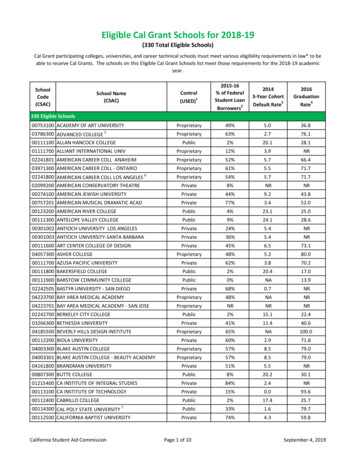
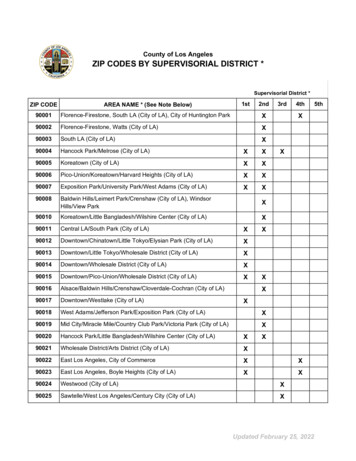
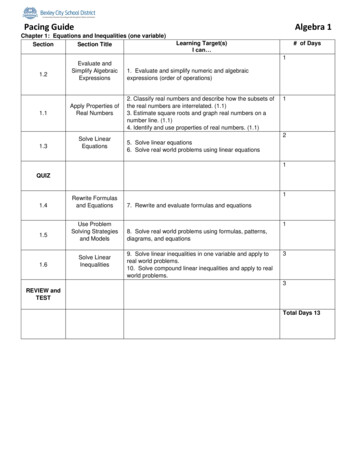
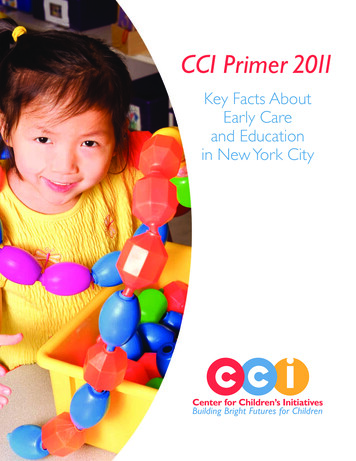
![Josh Smith - Agility [Read-Only]](/img/8/disaster-planning.jpg)
